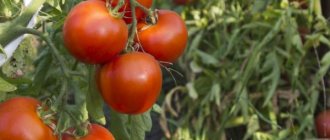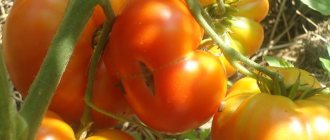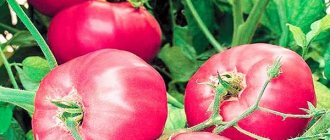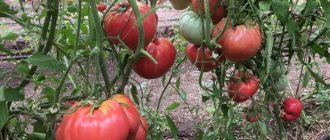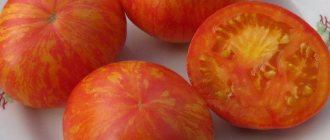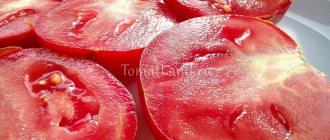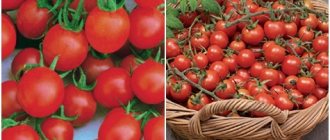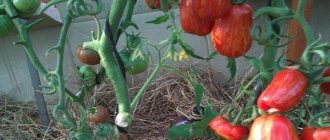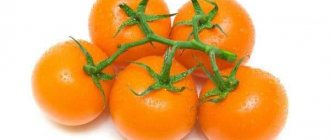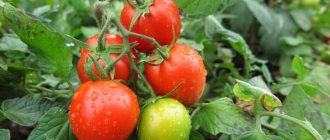The best and worst varieties of tomatoes: which ones to plant and which ones to avoid?
We recently celebrated the New Year and it would seem that spring is still far away, but the gardener’s heart is already beating faster in anticipation of the planting campaign.
But what varieties of tomatoes should you choose so that the coming year’s harvest does not disappoint? Last year, the clear favorites when choosing seeds were tomatoes: Honey Drop, Black Moor, Mazarin, King of the Market2, Sanka, which justified themselves with a bountiful harvest. Perhaps only Mazarin disappointed many by not showing the declared qualities.
Feedback from gardeners on tomato yield results will give you an idea of many varieties of tomatoes. As a result of the analysis, you yourself will be able to compile for yourself a list of seeds that you will purchase for planting.
Didn't like these tomato varieties
- Atlantis
(SibSad) - terrible small (50-60 gr.) sour, on a powerful and strong trunk, although it didn’t hurt. - Boni MM
- I didn’t like it at all, neither in taste nor in quantity, and I didn’t have it at all early. - Bobcat and Slot
are productive, but the taste is the most common, market one. - Boogie - woogie
- not early and tasteless. - Yellow cherries
- tasty, sweet, lots of them, but very small and almost all of them were cracked - Irishka F1
(Russian vegetable garden) - cold-resistant, unpretentious, so-so, nothing special. - Koenigsberg red
- suffered from blossom end rot, low yield. - A Moscow delicacy
- very tasty, meaty icicles. Not very productive. Sick with Koenigsberg from apical rot - Honey-sugar
(SibSad) - “oak” store-bought tomatoes, although yellow in color, lasted the longest on the windowsill, but the taste changed for the worse. - The mandarin duck
was not impressed, in my opinion the honey drop is better, although the tomato is half the size. - Mazarin
was not impressed. - Eagle Heart
- I got sick first, I didn’t get any tomatoes. - Pink Leader
is the worst variety of this year in terms of fruit taste and yield. - Siberian Lights
- large cream, but empty inside - Timofeich
- fruitful, sweet and sour taste - Wonder of the world
- a lot of tomatoes, bears fruit for a long time, unpretentious. Beautiful fruits with a spout. The taste is sour both in salads and in preparations. In salads, the juice is white-yellow-watery.LET'S CLEAN UP!
- Jason
(Zedek) - tasteless
Read more about tomato varieties here!
View all posts by klarinia
Video
Tomato variety Large pasta Carol Chico! Full review of the variety
THE BEST VARIETIES OF TOMATOES THAT I WILL NOT REFUSE AND RECOMMEND TO EVERYONE! REVIEW OF YIELD VARIETIES.
PINK BEEF TOMATO QUEEN F1
Tomato variety Alhambra F1! Full review of the variety
SUPER EARLY TOMATO WITH TASTE! – VEROCHKA F1
The best varieties of meaty tomatoes. 5 varieties of large-fruited tomatoes. Tomatoes 2022 Siberian selection.
Tomato variety Fox! Full review of the variety
New varieties and hybrids of tomatoes have gone on sale.
Description and characteristics of the Pronus tomato variety
Bush care
The most difficult part of Boogie Woogie cultivation is proper pruning. Bushes are formed into 1-2 stems, depending on planting density. Lateral stepsons above the 3rd hand must be removed regularly. It is best to do this when the length of the shoot is 4-5 cm. This reduces the risk of confusing the stepson with a growth shoot and creates the opportunity to leave a “stump” to prevent the appearance of a stepson in the same place in the future.
Other rules of care:
- Tall bushes may fall to the ground during the fruiting period, so they need to be promptly tied to supports, trellises or the greenhouse frame. Contact of tomatoes with the soil surface provokes the development of fungal diseases and impairs the quality of tomato ripening;
- Plants need shallow (up to 25 cm into the soil) watering every 3-5 days. The need for watering is determined when the top layer of soil dries. The following recommendations should be followed: Use only settled warm water;
- Water early in the morning or late in the evening;
- Avoid contact of liquid with green parts of plants;
- In the intervals between waterings, the soil must be loosened, preventing the earth crust from hardening;
Grandmother's Kiss - Tomato plant variety
Information on admission Tomato Babushkin Kiss from the Register of the State Variety Commission of the Russian Federation
Application for admission No. 46091, registered 2006-11-28. The Tomato variety Babushkin Kiss was included in the register of those approved in 2008. Approved for use in regions: All regions.
The originator of the Tomato variety Babushkin Kiss is:
Information about the patent for the Tomato variety Babushkin Kiss
Patent holder of the Babushkin Kiss variety:
LLC AGROFIRMA SEEDS OF ALTAY (656015, BARNAUL, PROFINTERNA STREET, 9)
Application for protection of the Babushkin Kiss variety No. 46092, registered 2006-11-28.
Patent No. 3992, registered 2008-05-20. Estimated patent expiration date 2038-12-31.
- Kotelnikova Marina Aleksandrovna
- Antipova Nadezhda Petrovna
Other varieties of tomato plant
Question to the portal experts
If you haven't found the answer to a question, don't hesitate to ask an expert.
Register or Login so you don't have to enter your Name and Email every time
Thanks for the comment! It will be published after checking by a moderator!
No comments yet, be the first!
A portal for those who love their dacha
Your question has been sent for moderation. Don't worry, we quickly check your questions and your question will be answered within 1 day.
We have noticed that you are already registered on our website. We recommend that you log in to view the created question.
If you don't remember your password, you can recover it.
You were not registered until today, so we have registered you. Your password has been sent to your specified mailbox.
Help our site develop!
Please read this message, it will not take up much of your time!
We so need your comments and questions to understand in which direction we should develop.
Don't forget to leave a comment if you found what you were looking for. And if you haven’t found it, use the “Ask an Expert” form in the site header. We will answer this question, and other visitors will be able to find the information that you could not find.
Your question has been sent for moderation. Don't worry, we quickly check your questions and your question will be answered within 1 day.
We have noticed that you are already registered on our website. We recommend that you log in to view the created question.
If you don't remember your password, you can recover it.
You were not registered until today, so we have registered you. Your password has been sent to your specified mailbox.
Growing tomatoes
Like other varietal tomatoes, “Boogie Woogie” is grown in seedlings and then planted in a stationary greenhouse, hotbed or open ground. The variety has a tendency to quickly degenerate, so self-collected seeds do not germinate. For each sowing you need to buy new material.
How to prepare seeds?
Seeds of F1 hybrids are sold completely ready for planting. To improve germination and shorten the growing season, you can treat them with growth stimulants: “Sodium Humate”, “Epin Extra”. A solution of wood ash is used as a cheap alternative.
Sowing seed material
Sowing is carried out in March - approximately 2 months before the expected date of the last frost. As soil for seedlings, mix turf and humus in a 1:1 ratio. If necessary, dilute with sand. The seeds are laid out on the surface at intervals of 3 cm from each other, then sprinkled with peat and watered abundantly.
Optimal temperature for keeping seedlings:
- Before emergence – 25*C;
- During the hardening period (within a week after the sprouts “peck”) – 16-18*C;
- Before planting in the garden – 20-22*C.
IMPORTANT: For sowing, you can use any container with a depth of 5 cm or more that has a sufficient number of drainage holes, including containers for cookies and sweets, “chests” made of tetrapacks, and wooden boxes. Picking is usually carried out in cut plastic bottles or peat pots. Picking is carried out after the formation of the second true leaf
Seedlings need to be constantly watered, keeping the soil moist, and periodically fed with complex fertilizers
Picking is carried out after the formation of the second true leaf. Seedlings need to be constantly watered, keeping the soil moist, and periodically fed with complex fertilizers.
Rules for planting seedlings
At two months of age, the seedlings are transplanted to a permanent location. In open ground - in the 2-3rd decade of May, in a greenhouse - in late April - early May. The earth at this time should be warmed up to 10*C, and the average daily air temperature should be about 15*C. The plants are transplanted into pre-prepared planting holes 12-15 cm deep. Superphosphate and a small amount of wood ash are placed under each bush.
IMPORTANT: When replanting, it is extremely important not to damage the roots of the plant. The most convenient option is replanting in a peat pot. Recommended planting scheme:
Recommended planting pattern:
- The distance between plants is 50 cm;
- Row spacing – 60 cm;
- The maximum planting density is 6 plants per 1 sq.m.
When planting “Boogie Woogie” in open ground, you should cover the plants with film at night during the first week.
Tomatoes: advantages and disadvantages
Advantages of this variety:
- Fast ripening;
- Excellent product and taste qualities;
- High yield;
- Keeping quality for a long period;
- Immunity to specialized diseases of nightshade crops.
Being a first generation hybrid, Boogie Woogie has virtually no disadvantages. The negative features of the variety include :
- Demanding on shaping and gartering;
- The need for annual renewal of seed material.
How to grow Boogie Woogie tomatoes
Among the hybrids and varieties of tomatoes, pink-fruited ones are considered the most delicious. Judging by the reviews of gardeners, the Boogie Woogie tomato fully confirms this opinion. In addition to beautiful fruits (see photo) and excellent taste, the hybrid is famous for its unpretentiousness and high yield rates. Recommended for regions with temperate climates, for cultivation in shelters (film and polycarbonate greenhouses, greenhouses).
Description of the variety
Boogie Woogie is a hybrid tomato characterized by fast ripening and resistance to adverse factors. Since 2007, the variety has been included in the State Register catalog and is grown in different areas.
The fruits ripen early, reaching technical ripeness after 100-103 days. On heavily leafy bushes, several clusters of 3-5 tomatoes each are formed. The plants are powerful, strong, although not particularly tall (up to 1.3 meters). The root system is well developed, the leaf blades are medium sized and bright green in color.
Ask and receive useful advice from professional gardeners and experienced summer residents.>>
It is recommended to grow plants in 1-2 trunks, cutting off excess leaves and removing stepsons in a timely manner.
Belongs to the indeterminate group, requires increased nutrition and timely watering. The fruits are smooth, beautiful, rich pink in color. There are no stripes or spots. By weight - 250-290 grams.
The pulp is very juicy, fleshy and dense. Inside there are 3-4 chambers, few seeds. Therefore, the fruits are used to prepare salads, pasta, ketchup, sauces, and soups. It must be taken into account that during processing the tomato mass is not bright red, but pinkish in color.
The fruits taste sweet, with a pleasant aroma. Sugar content is about 3%. The taste depends on the correct agricultural technology, regularity of fertilizing and watering.
Suitable for short-term storage and transportation. In boxes and boxes they keep their shape and retain their presentation.
Advantages and disadvantages
The hybrid has no obvious disadvantages. It is hardly worth considering the need to form a bush and install trellises as a “minus”.
good tomato taste; high product characteristics; early ripening (important for regions with difficult climatic conditions); the ability to grow in shelters, on ridges; good yield (up to 5-6 kg per plant); friendly return of fruits; resistance to diseases (fusarium wilt, tobacco mosaic virus).
Gardeners note that the fruits can be canned and used for pickling (in slices). Hybrid Boogie Woogie F1 is planted in different areas, there are no particular complaints or negative reviews.
Features of agricultural technology
In most regions of the country, the hybrid is grown through seedlings. The timing of sowing seeds is calculated based on the climate and growing conditions (on ridges, in shelters).
The seedlings should be 58-65 days old at the time of planting, strong and healthy.
Before planting, tomatoes must be accustomed to new conditions. Hardening promotes rapid adaptation and increases plant immunity to diseases.
When the soil warms up to +14ºC...+16ºC, plants can be planted, following the distance recommendations. The hybrid has powerful growth, so leave at least 50-60 cm between the bushes.
Small tomato seedlings in beds are initially covered with non-woven material or film and watered after planting no earlier than 5-6 days later.
Further standard care:
- rare but abundant watering;
- adding nutrient mixtures (3-4 times during the summer);
- loosening;
- mulching;
- formation of bushes;
- regular removal of stepchildren.
Preventative spraying of the variety against diseases and pests is carried out. The tomato is little susceptible to infections; it “escapes” late blight due to the early ripening of the fruit.
In the first period of the growing season, nitrogen makes up a significant proportion of the fertilizing, and in the second half - potassium and phosphorus. Watering a hybrid tomato with an infusion of herbs and yeast gives a good effect.
Harvest tomatoes as they ripen. It is allowed to harvest tomatoes at the stage of technical ripeness in order to allow the next batches of fruit to form
The Boogie Woogie tomato is one of the promising hybrids recommended for cultivation on farms and on the plots of amateur gardeners.
Reviews about the variety
Gardeners like this variety for its compact bush appearance, disease resistance and tasty fruits. It is noted that the size of the fruit is often slightly smaller than stated - about 150-200 grams, but the marketability of the tomatoes is not satisfactory. If crop rotation is observed, "Boogie Woogie" produces a stable harvest from year to year.
The Boogie Woogie tomato, reviews, photos and productivity of which are presented in our article, is in great demand among most gardeners. Further in the article you will be able to study the description and characteristics of the variety and fruits, find out its advantages and disadvantages , and also read photos and reviews of those gardeners who have already grown the Boogie Woogie tomato variety .
Description of the Kokhava tomato and characteristics of the variety
Tomato Kokhava f1 is an indeterminate hybrid, which was bred by Russian breeders. A positive characteristic of the variety is its high yield and early ripening. The plant is characterized by good immunity and is resistant to many diseases.
Plant characteristics
Kohava is a hybrid that is also indeterminate and quite tall. The plant has medium leaves that are dark green in color and forms a strong root system. The tomato has simple inflorescences; on average, 5-6 tomatoes are formed on one ovary.
Due to its parameters and characteristics, the plant is characterized by a good immune system and is not afraid of diseases such as late blight. But at the same time, damage from external pests cannot be ruled out. Therefore, if damage to the trunk and leaves from pests is noticeable, it is better to treat the plant with a weak solution of manganese.
The downside of the plant is that it is a hybrid, so getting seeds for next year to grow seedlings will be quite a painstaking task.
Description of the fruit
The fruits have a flat-round shape and a pale pink color. The average weight of a ripe fruit is 150 grams. On average, 5-6 fruits ripen on one cluster. The weight and size of a tomato depends on the number of tomatoes ripening on the bush. The fruit has a bright red color and an interesting shape.
Vegetables of this variety are characterized by good keeping quality and are convenient to transport over long distances. This variety is not characterized by cracking. In this case, the tomato will not lose its presentation.
If you store vegetables in a cool place, they can last for a long time. Tomatoes can be used both for fresh consumption and for preservation. The rather large fruit makes it possible to effectively use tomatoes for tomato juice.
How is sowing done?
The tomato is a hybrid, so the seeds must be purchased at a specialty store. Before planting seeds, it is necessary to prepare the soil and treat the seeds with manganese. This must be done to prevent future tomatoes from contracting the disease. The seeds are sown to a depth of 2 cm and the box must be placed in a warm and sunny place.
After the seeds have hatched, after the first leaf it is necessary to prick the seedling in order for it to strengthen. Plants must be planted when they are 55 days old. To obtain earlier fruits, you can plant seedlings in a greenhouse. Care consists of regular watering, loosening the soil and fertilizing the plant. On average, there are 3 adult plants per 1 square meter. In these growing conditions they will feel comfortable and bear fruit.
Origin and application
The “Boogie Woogie” hybrid was bred by Russian breeders and is intended for cultivation on industrial farms and in amateur farmsteads. Planting in open beds, greenhouses or greenhouses is possible.
The fruits are very well stored and can be transported over long distances. Tomatoes picked green ripen quickly at room temperature . Juicy, fleshy tomatoes of the Bug Woogie variety belong to the salad type.
They can be eaten fresh in a variety of dishes, from appetizers to soups. The ripe fruit produces a delicious sweet juice with a beautiful pink hue.
Tomato Boogie Woogie: characteristics and description of the variety with photos
The high-yielding hybrid of pink tomato Boogie Boogie firmly occupies a market place in its segment. Vegetable growers in all regions liked it because it gives an early harvest and exhibits high resistance to diseases, and consumers liked it for the high taste of the fruit.
About the hybrid
The Boogie Boogie tomato variety shows its qualities best in spring film plantings, early ripening. Recommended for cultivation in all regions. The bush is indeterminate, 1.2-1.3 m high, forms a powerful biomass, which must be restrained by pruning the shoots and lower leaves. It is acceptable to grow a bush with one or two stems.
The description of the fruit characterizes these tomatoes as the best in their segment. The weight of the fruit is at least 250 g, the color of a ripe tomato is rich crimson-pink, there are few seed chambers in the fruit - no more than four. Tomatoes are flat-round in shape, excellent taste, sugar content of at least 3%.
The fruits of this variety are suitable for making salads, juices, ketchups, and tomato paste. They are tied in clusters of 3-5 pieces, ripen smoothly, are highly transportable, hard, and do not wrinkle or crack during transportation. Ripen well at home
Characteristics also indicate its high resistance to tobacco mosaic virus, fusarium wilt and powdery mildew, which is very important for greenhouse tomatoes
Features of cultivation
The tomato variety Boogie Woogie F1 is an early ripening tomato; to obtain an early harvest with the highest price, it must be grown by seedlings. Sowing seeds of this variety should be carried out as early as possible - starting from February 15.
To prevent the seedlings from stretching out, the temperature in the room is reduced to 16-18 oC, the plants are given additional light and must be fed with humin-based fertilizers 3-4 times. Plants are transferred to a permanent place in the greenhouse in late April - early May. Planting at such a time is guaranteed to ensure an early harvest, which is inherent in the potential of this variety.
Getting the autumn harvest
Boogie Boogie tomatoes are best suited for growing without seedlings and obtaining late products for storage and ripening. This is due to the powerful root system that the bushes form. If they are not replanted, the roots are able to penetrate to a depth of over 0.6 m. The plants are more resistant to drought, they can be watered and fed less frequently.
Sowing seeds in open ground is carried out at the end of May - beginning of June according to a 70 x 10 cm pattern. Shoots appear in 5-7 days, they need to be thinned out to a distance between bushes of 30-40 cm. A number of growing plants form a wall, which requires the construction of a trellis and garters. All bushes are led into one stem, the stepsons are removed using small pruners or scissors, previously disinfected in alcohol or by calcination over fire.
Plants need feeding. The best results are obtained with organic fertilizers, for example, infusions of mullein or bird droppings aged for 7 days, diluted 20 times. Such feeding must be done every 2 weeks. As the plants grow, the lower leaves are cut off, exposing the fruit to air and sunlight. They will be sweeter and brighter in color.
The Boogie Woogie F1 tomato has received a lot of positive feedback from vegetable growers and consumers, try planting it on your plot, it will definitely delight you with delicious fruits throughout the season!
Tomato Boogie Woogie - description and characteristics of the variety
Statute
The fruits are tasty and beautiful, with a high content of dry matter and sugar. The Boogie Woogie tomato reaches a height of 1.2 m and requires tying and removing the shoots. The leaves are dark green, the fruits are pink, slightly flattened. Tomatoes are universally used, suitable for fresh consumption, without purpose and for canning.
Growing and care
If desired, you can grow the Boogie Woogie tomato in an area where the frost-free period is extremely short. To do this, you can use a greenhouse or raise seedlings first at home, in a warm place. Then the conditions for the growth and development of plants will be suitable, this gives a chance to grow those crops that have a long growing season.
In order for tomatoes to grow well, they need to be planted 30-60 days before transplanting into the ground, depending on the crop. For successful cultivation, a number of rules must be followed.
Compliance with light conditions. Provide one of the most important indicators. At elevated temperatures in combination with a small amount of light, the plant will grow frail, weak, stretch upward and not become overgrown with greenery. The root system will also be weak, and the plant itself will be pale. Of course, such tomatoes will bear fruit poorly. From time to time, daylight hours need to be reduced to prevent tomato seedlings from overgrowing. And this should not be done from the very beginning of planting. Temperature is no less important. Too low temperatures will not allow plants to develop, but it should also be too hot and deserted (= sparsely populated) - this increases the respiration of seedlings, especially in combination with low light. Plantings are covered with glass, polyethylene or paper. Before the first shoots, the liquidus should be about 20-25 degrees, when the first grains appear, you can open the polyethylene slightly and cool to 17-19 degrees during the day and 15-17 at night. This will help harden off existing seedlings. In sunny weather, you can keep the temperature around 22-25 degrees, and at night - up to 17. In cloudy weather, you can bring the temperature closer to 19 degrees. Soil compactness. For seedlings, the soil must be highly nutritious, highly absorbent, allow air to pass through and retain water. You can transform a mixture of one part turf soil, two parts sand (if it is loose, you can replace it with sawdust) and one part humus. For large-fruited tomatoes, add 60 g of superphosphate and 20 g of potassium sulfate or wood ash in a volume of 2-3 cups to a bucket of the mixture. Very often, when transplanting seedlings, a significant part of the roots of plants is cut off. This happens because the root system is very branched and takes up a considerable amount of soil. The roots are then restored, but this is not a quick process. If you grow each plant in a paper or polyethylene pot with a nutrient mixture, then such problems will be of little use. You can also use disposable cups, cut-off bottles or small ceramic pots. The main thing is not to forget to make drainage holes in homemade pots. It is not a sin to grow Boogie-Woogie hybrid seedlings in a greenhouse. The lighting also deserves special attention. Seedlings can't do anything with 12-18 hours of sunlight! And in the middle latitudes the sun is scanty even on the sunny side, especially in winter and early spring - there can be up to 6 hours of direct sunlight per kalpa
Therefore, additional lighting is extremely important. The first point of proper lighting is the stepwise arrangement of seedlings near the window (if the seedlings are grown in the house). Closer only to the window are low specimens, then those that are taller
A political device of mirrors is also necessary, which will direct all the light to the seedlings. And even then you can’t do without lamps. They are located at different heights, but best of all - as close to the seedlings as possible.
It is allowed to use ordinary lamps from a hardware store - energy-saving, fluorescent. You can buy lamps in a specialized store. There you can choose options for stimulating growth, for good photosynthesis and much more. If you like, you will need several lamps. The lighting turns on early in the morning, then during daylight hours it can be turned off and turned on in the evening. Even if there is little light, it is possible to illuminate throughout the day, that is, even around the clock.
This variety of tomatoes is suitable for those growing in the northern regions. For seedlings, greenhouses are used, in other words, seedlings are grown at home, in the warmth. Delicious pink fruits will delight above 95-100 after the first shoots appear.
Tomato Boogie Woogie
New hybrid with high yield
- Fact:
From one Boogie Woogie bush you can harvest 4–5 kg of selected tomatoes. - Fact 2:
The variety is in demand due to its high resistance to diseases - fusarium, powdery mildew, and tobacco mosaic virus. - Fact 3:
The harvest is universal in use. Suitable for preparing fresh vegetable dishes, for preservation and processing. It is well stored and does not deteriorate during transportation. - Fact 4:
“Boogie Woogie” needs to form a stem (removing side shoots above the 3rd brush and above), tying it to a vertical support. You can place supports under the lower branches with fruits.
This is also interesting!
"Boogie Woogie" is an early ripening hybrid. He is not afraid of diseases and does not require complex care. The harvest is distinguished by high taste and commercial characteristics. The variety is intended for private and industrial cultivation.
a brief description of
- Where to grow: in greenhouses and open ground
- Bush height, cm: 120–130
- Ripening time, days: 103
- Productivity, kg: 4–5 per bush
- Fruit weight, g: up to 300
- Application: salads and vegetable dishes, preparations
- Advantages:
large fruit; - transportability;
- ripening;
- resistance to diseases and pests;
- productivity.
- trunk formation;
Description
Hybrid varieties are in demand due to their high resistance to diseases - fusarium, powdery mildew, and tobacco mosaic virus. As well as high yields. From one Boogie Woogie bush you can harvest 4–5 kg of selected tomatoes. They have:
- flat-round shape;
- rich, uniform color;
- there is no green spot on the stalk;
- few seeds;
- juicy pulp;
- sugar content almost 3%;
- sweet, not watery taste.
The bush belongs to the indeterminate type. It is abundantly covered with small dark green leaves. Grows up to 1.3 m. Such plants require pinching of the top to limit growth. Otherwise, tomatoes do not have enough strength to form and develop fruits.
The harvest is universal in use. Suitable for preparing fresh vegetable dishes, for preservation and processing. It is well stored and does not deteriorate during transportation. Ripens perfectly at home without loss of taste.
Growing
The optimal growing method is seedlings. To do this, in mid-March, the seeds are disinfected with a solution of potassium permanganate or hydrogen peroxide. Soak overnight in a growth stimulator.
The soil mixture can be purchased at the store or prepared independently from turf soil, humus, and ash. The seeds are placed in a container on compacted soil. Sprinkle with a 1-1.5 cm layer of peat. Provide a temperature of 23-25˚C. Cover with film and keep warm until germination.
The seedlings are freed from shelter and moved to a sunny place. Water with a spray bottle or through a strainer and loosen. After several full-fledged leaves appear, they are picked and fertilized. A week before transplanting to the dacha, the seedlings are hardened off - taken out into the fresh air or onto the balcony. At first, such “walks” last 2–3 hours. Gradually their duration increases.
In the garden plot, the beds are first dug up with humus and ash. A tablespoon of fertilizer - superphosphate and potassium sulfate - is added to the wells. Planting pattern – 40 x 60 cm. Plants from open ground are covered with film for the first few days.
Conventional agricultural technology for tomatoes:
- watering after sunset;
- mulching;
- ventilation of the greenhouse;
- loosening;
- weeding.
"Boogie Woogie" needs to form a stem (removing side shoots above the 3rd brush and above), tying it to a vertical support. You can place supports under the lower branches with fruits. The variety is rarely attacked by insects and diseases. Proper care will help you avoid problems.
Fruit characteristics and cultivation
Next, the characteristics of the Boogie-Woogie variety and the features of its cultivation will be presented. Tomato Boogie Woogie F1 loves a lot of light. Grown in open ground under the warm rays of the sun, they acquire a sweet taste. To prevent the plant from getting a fungal disease and starting to rot, you should follow the watering schedule and maintain low humidity in the room.
Like most hybrid varieties, typical tomato diseases are:
- fusarium;
- verticillium;
- nematodes;
- tobacco mosaic.
Description of the Apricot F1 tomato and agrotechnics for growing the variety
Read
Tomatoes almost never get affected by late blight because they ripen early.
Many agronomists advise mulching the soil, which protects the soil surface from drying out. You need to take: straw, mowed grass, sawdust leaves, compost, film, as well as newspapers or cardboard. The bottom line is that any of these coatings acts as a barrier from the sun's rays, which means the soil will not dry out quickly and need frequent watering. But in a confined space, you need to ensure that the air humidity level does not increase due to water evaporation.
The best time to plant seeds is the end of March - beginning of April. For the purpose of disinfection and disinfection, seeds are dipped into a light solution of potassium permanganate before planting. Planting is done in a small container and covered with a thin film. There is no need to water the planted seeds. As the soil dries, it is better to spray them with water. Until the first sprout appears, the container is kept warm, but then it is transferred to a bright place so that the plant begins to grow quickly.
When the leaves on the seedlings get stronger, you can proceed to planting in the ground. When planting, there should be a distance of at least 50 cm between plants. Every 2 weeks you need to fertilize with complex fertilizer or organic matter. Tall bushes should be tied to a support. This way the plant will receive more light and will be easier to care for. To ensure that tomatoes receive enough nutrients, you need to remove the lateral shoots that appear between the stem and leaf.
Diseases and pests
"Boogie Woogie" is highly resistant to disease:
- Tobacco mosaic;
- Fusarium;
- Golden nematode;
- Verticillium.
Due to early ripening, the variety does not suffer from late blight. To prevent fungal diseases, preventive measures should be taken :
- Maintain air exchange in the garden bed and in the soil;
- Find the optimal watering rate at which the soil would be sufficiently moist, but the liquid would not stagnate in the garden bed;
- Mulch the rows with chopped straw or peat. This saves the soil from overheating and inhibits the growth of weeds.
Of the pests, the greatest damage to plants is caused by the Colorado potato beetle, spider mite and cutworm. To combat insects, tomatoes are sprayed with the insecticides Fitoverm and Karbifos.
